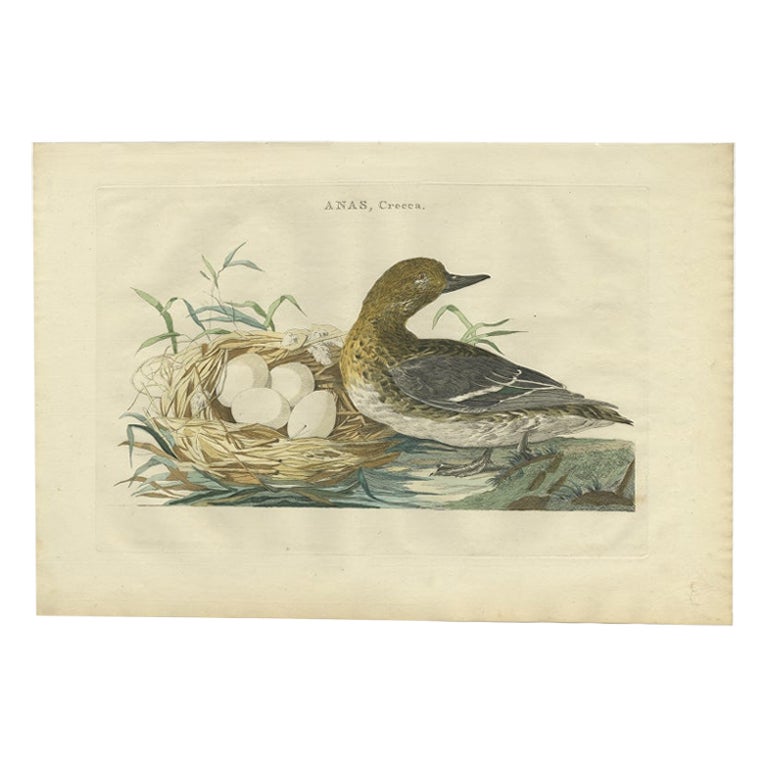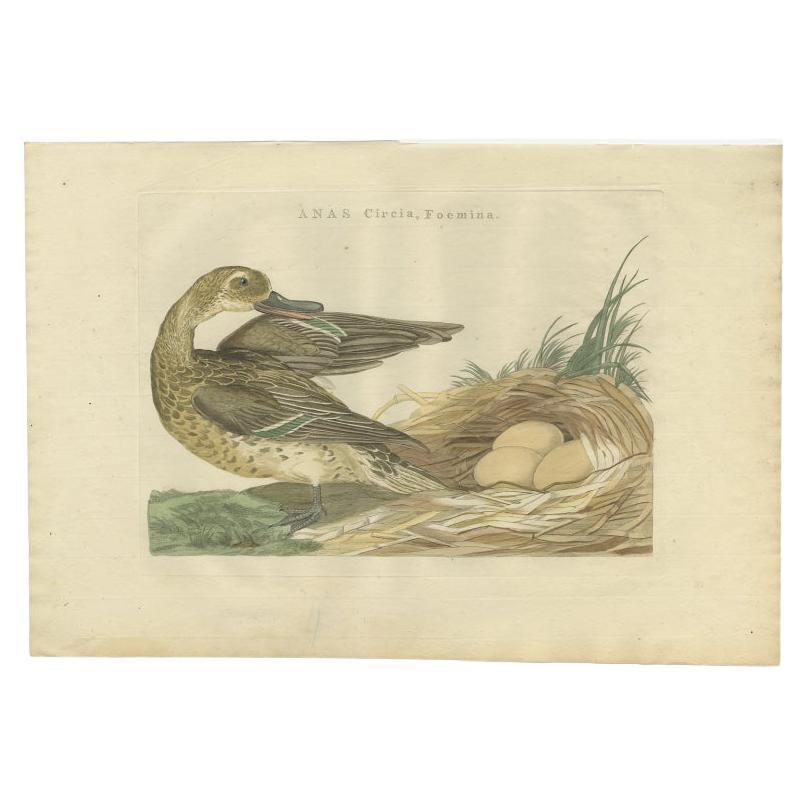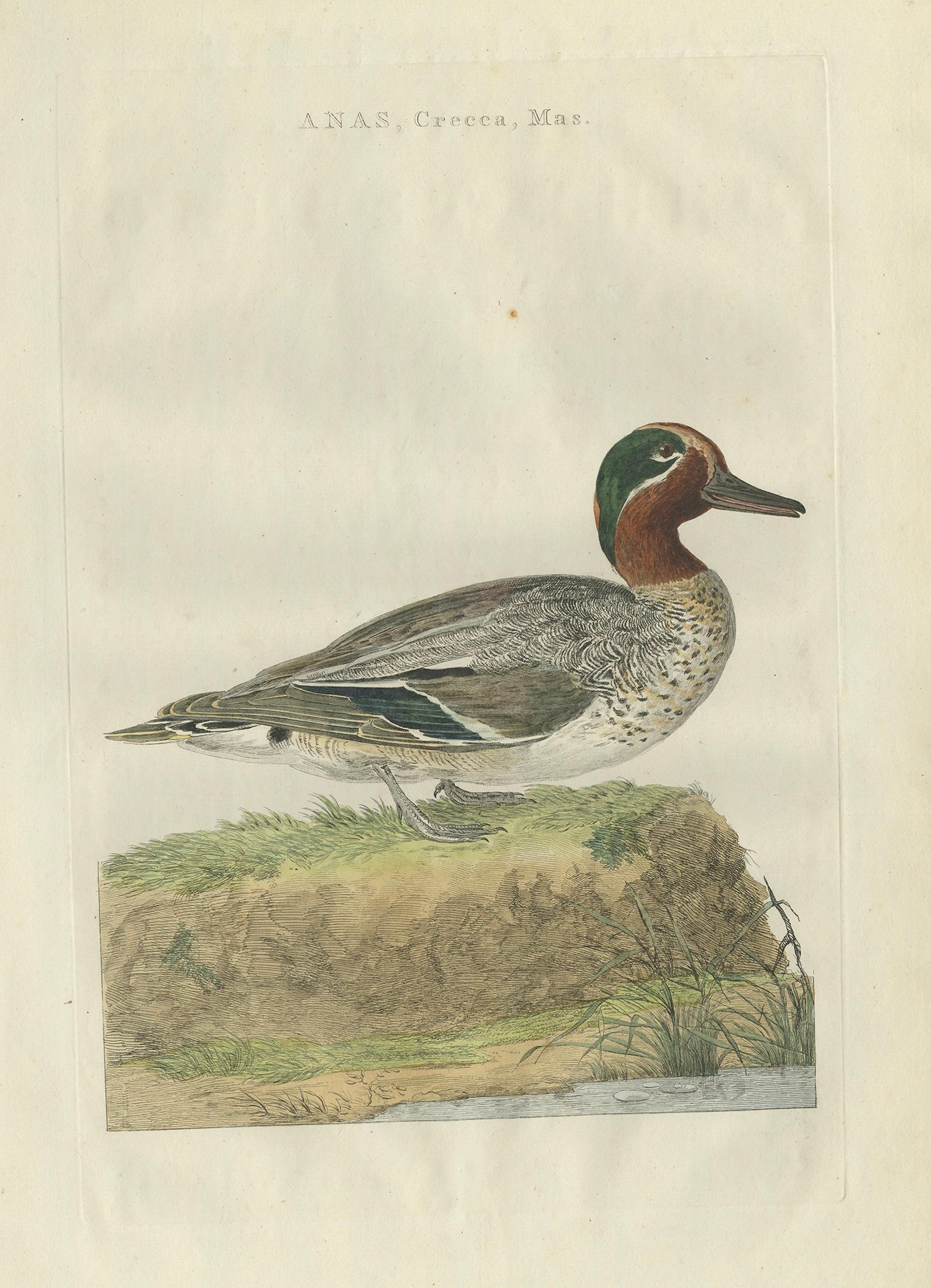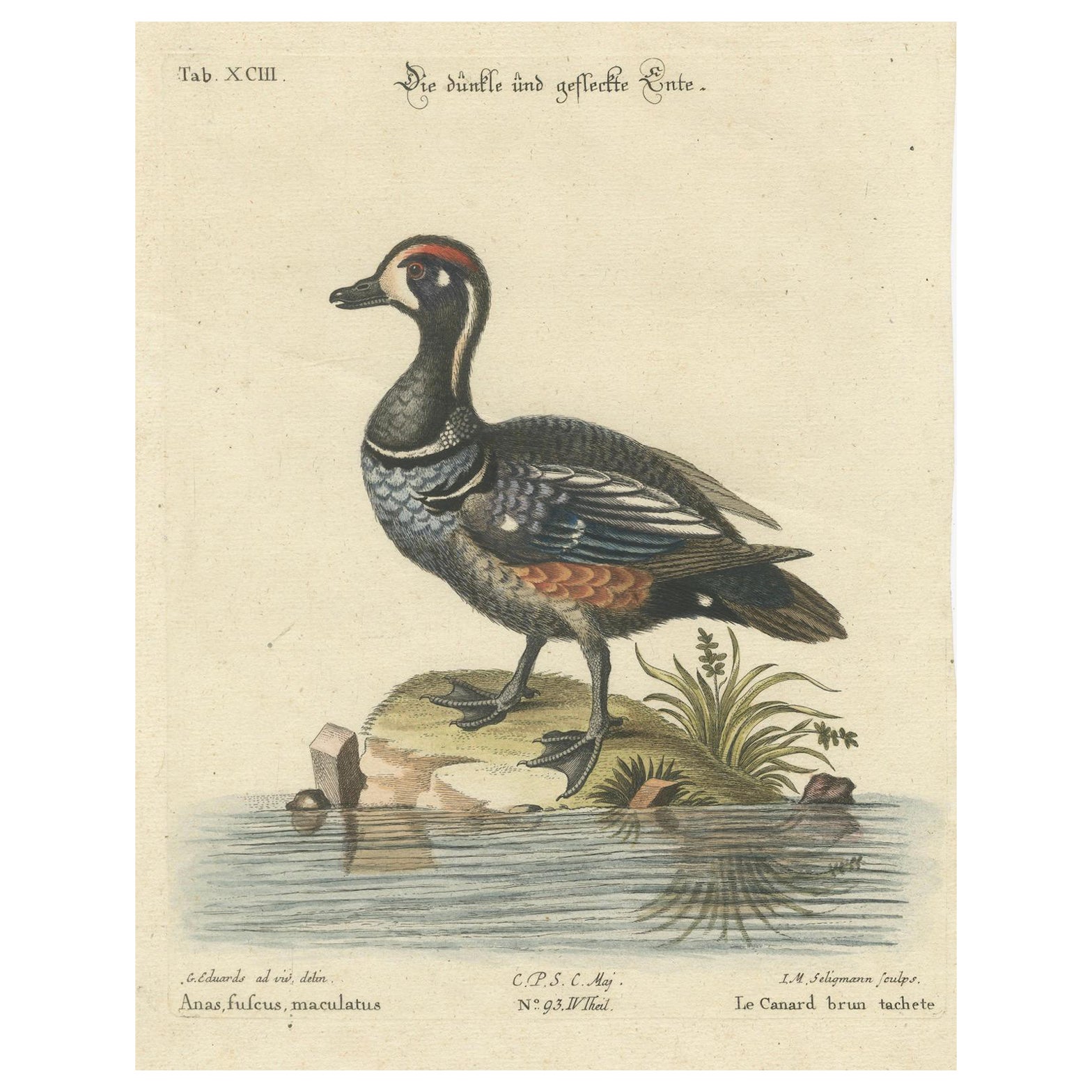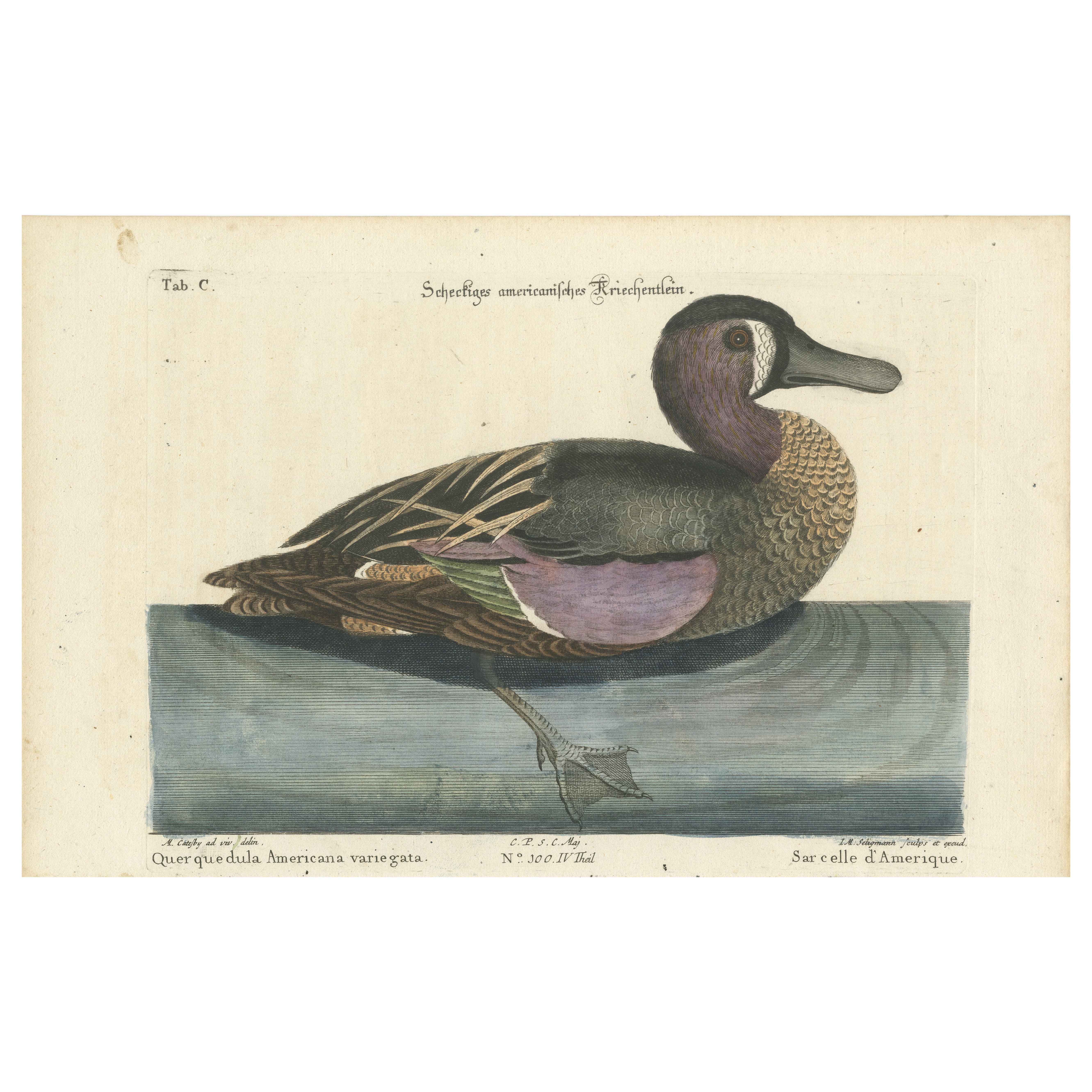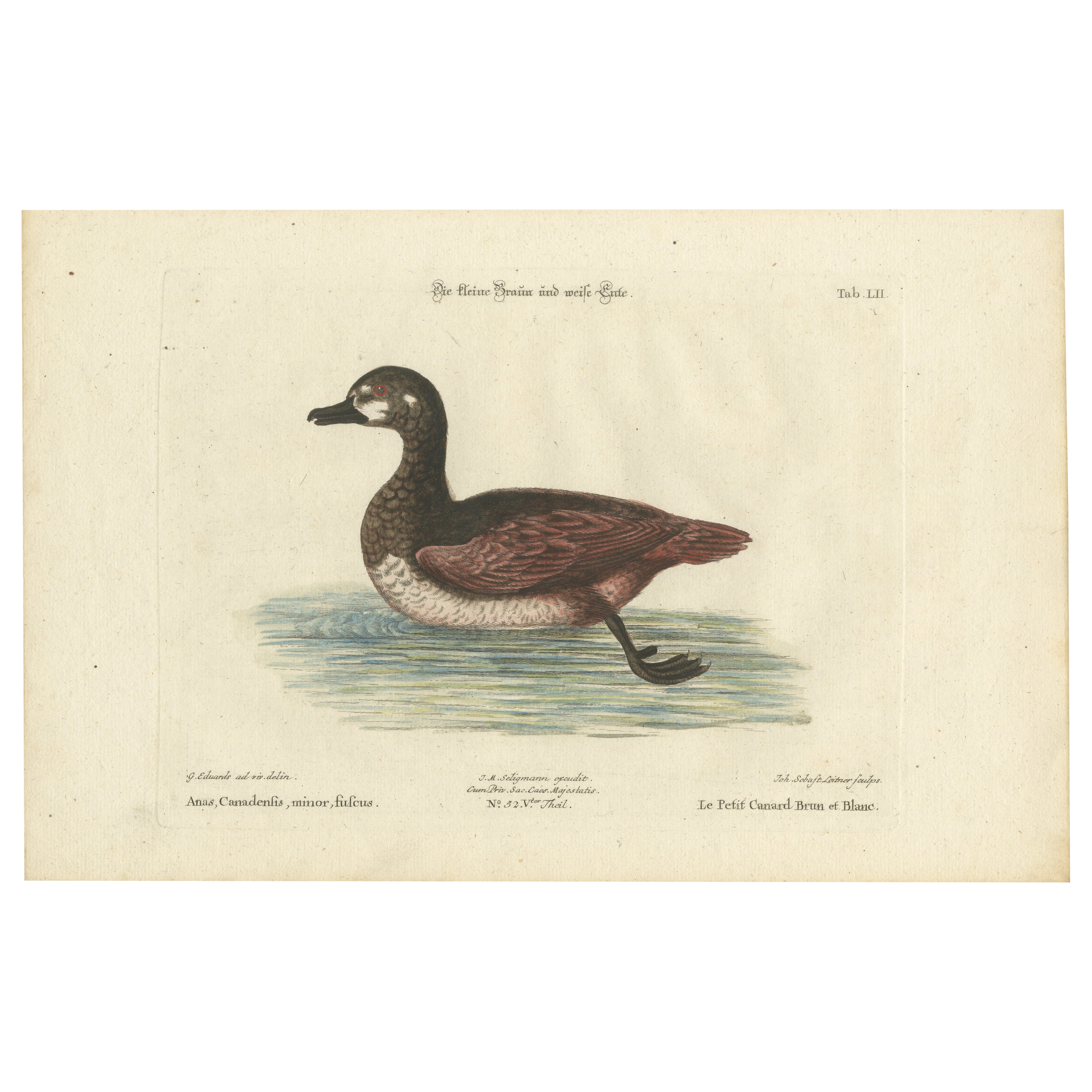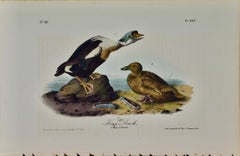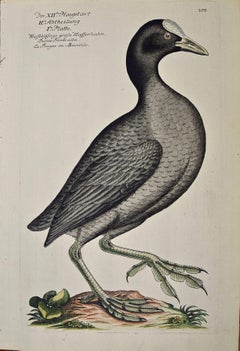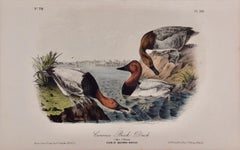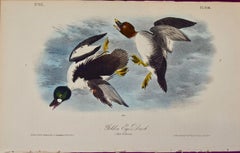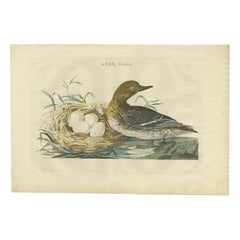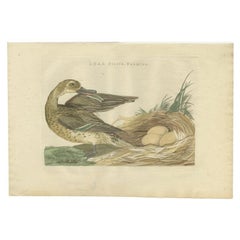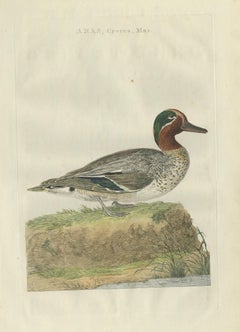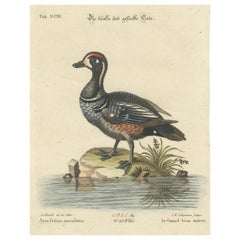Items Similar to Eurasian Teal Duck: An 18th Century Hand-colored Nozeman Engraving "Anas Crecca"
Want more images or videos?
Request additional images or videos from the seller
1 of 8
Cornelis Nozeman and Jan Christiaan SeppEurasian Teal Duck: An 18th Century Hand-colored Nozeman Engraving "Anas Crecca"1770
1770
$1,275
£953.98
€1,107.17
CA$1,775.28
A$1,996.80
CHF 1,035.69
MX$24,222.60
NOK 13,132
SEK 12,357.95
DKK 8,259.81
Shipping
Retrieving quote...The 1stDibs Promise:
Authenticity Guarantee,
Money-Back Guarantee,
24-Hour Cancellation
About the Item
This is a rare 18th Century hand-colored large folio-sized copperplate engraving entitled "Anas Crecca" (Eurasian Teal) by Cornelius Nozeman in volume II of his publication 'Nederlandsche Vogelen', engraved by Christiaan Sepp or his son Jan Christiaan Sepp, published in Amsterdam in 1770. This engraving depicts a female Eurasian Teal duck standing on guard next to her nest containing four eggs. She appears to have been alerted to a possible danger behind her. The Anas crecca or Eurasian teal is also known as the common teal or Eurasian green-winged teal and sometimes simply a teal because of it is commonly a blue-green (teal) color.
The engraving is printed on thick, watermarked, laid, chain-link paper with wide margins. It is in excellent condition.
The work took nearly 60 years to complete all five volumes. The first two volumes were created by Nozeman and Sepp and after they died by Dr. Martinus Houttuyn & C. J. Temminck worked on subsequent volumes, volume V completed in 1829. The work is very scarce with one of the last complete sets selling for $92,000 at auction.
Cornelius Nozeman (1721-1786) was a Dutch minister and an ornithologist. Nozeman and Christiaan Sepp along with his son Jan Christiaan Sepp collaborated on the creation of the 1st two volumes of this ambitious work, with Nozeman writing the text and the Sepps creating the engravings. Martinus Houttuyn continued the work for the third volume, which was published in 1797. one year before he died. The fourth volume was published anonymously in 1809. The project was completed in 1829 with the publication of a fifth volume by Jan Sepp, the son of Jan Christiaan and grandson of Christiaan Sepp. The project involved three generations of Sepp family artists over the sixty years it took to complete the work. At the time of the final publication it was the costliest book ever published.
- Creator:
- Creation Year:1770
- Dimensions:Height: 14.25 in (36.2 cm)Width: 20.5 in (52.07 cm)
- Medium:
- Movement & Style:
- Period:1770-1779
- Framing:Framing Options Available
- Condition:
- Gallery Location:Alamo, CA
- Reference Number:Seller: # 4469 1stDibs: LU117327220242
About the Seller
5.0
Platinum Seller
Premium sellers with a 4.7+ rating and 24-hour response times
Established in 2011
1stDibs seller since 2019
285 sales on 1stDibs
Typical response time: 2 hours
- ShippingRetrieving quote...Shipping from: Alamo, CA
- Return Policy
Authenticity Guarantee
In the unlikely event there’s an issue with an item’s authenticity, contact us within 1 year for a full refund. DetailsMoney-Back Guarantee
If your item is not as described, is damaged in transit, or does not arrive, contact us within 7 days for a full refund. Details24-Hour Cancellation
You have a 24-hour grace period in which to reconsider your purchase, with no questions asked.Vetted Professional Sellers
Our world-class sellers must adhere to strict standards for service and quality, maintaining the integrity of our listings.Price-Match Guarantee
If you find that a seller listed the same item for a lower price elsewhere, we’ll match it.Trusted Global Delivery
Our best-in-class carrier network provides specialized shipping options worldwide, including custom delivery.More From This Seller
View All"King Duck": An Original First Octavo Edition Audubon Hand-colored Lithograph
By John James Audubon
Located in Alamo, CA
This is an original John James Audubon hand-colored royal first octavo edition lithograph entitled "King Duck, 1. Male, 2. Female", No. 81, Plate 404, from A...
Category
Mid-19th Century Naturalistic Animal Prints
Materials
Lithograph
Coot Bird, "Wasserhuhn": An 18th Century Hand-colored Frisch Engraving
By Johann Leonhard Frisch 1
Located in Alamo, CA
This is a rare 18th Century hand-colored copperplate engraving entitled "Wasserhuhn" (Coot) by Johann Leonhard Frisch , which is plate 208 from ...
Category
1730s Naturalistic Animal Prints
Materials
Engraving
Canvass Back Duck: An Original 19th C. Audubon Hand-colored Bird Lithograph
By John James Audubon
Located in Alamo, CA
This is an original John James Audubon hand-colored lithograph entitled "Canvass Back Duck, 1. Male 2. Female, View of Baltimore, Maryland", No. 79, Plate 395 from Audubon's "Birds o...
Category
Late 19th Century Naturalistic Animal Prints
Materials
Lithograph
Golden Eye Duck: an Original 1st Edition Hand Colored Audubon Bird Lithograph
By John James Audubon
Located in Alamo, CA
An original rare and extremely collectible first edition John James Audubon hand colored royal octavo lithograph entitled "Golden Eye Duck", No. 82, Plate 406, from Audubon's "Birds of America". It was lithographed, printed and colored by J. T. Bowen and published in Philadelphia between 1840-1844. It depicts male and female Golden Eye ducks in flight.
This original rare first edition hand colored Audubon bird lithograph is in excellent condition. The sheet measures 6.25" x 10". The original text pages, pages 362-366, from Audubon's publication are included.
John James Audubon (1785-1851) was a naturalist and artist. He was initially unsuccessful financially prior to the publication of his famous work “The Birds of America”, spending time in debtor’s prison, once stabbing a disgruntled investor in self-defense. However, his obsession with birds and art motivated him to persist in his goal of documenting every bird in America via his watercolor paintings and publishing his works for all to enjoy. Audubon's first illustrations were published in a large elephant folio size. Due to their expense they were purchased in rather small numbers by the wealthy. To reach a larger audience, Audubon, with the help of his sons and J. T. Bowen, published a smaller octavo sized lithograph version, which were much more affordable.
With the success of his bird projects, Audubon then turned his attention to four-legged animals. He explored the Missouri River in 1843 sketching the four-legged animals he encountered in their natural setting. His expedition covered some of the same regions recently explored by Lewis and Clark, traveling from present day Alaska to Mexico. Audubon realized that this was an opportunity to document these animals in the still relatively pristine American wilderness, before man encroached on their environment.
Between 1845 and 1848, Audubon and his sons John Woodhouse Audubon and Victor Gifford Audubon produced a set of elephant folio sized lithographs that were primarily engraved and hand colored by J. T. Bowen in Philadelphia. The publication, which included text descriptions of the animals was published 3 years before Audubon died. As with the birds, this was followed by a three-volume set of 155 octavo-sized plates entitled “The Quadrupeds of North America” completed and published by Audubon’s sons, John, Jr. and Victor.
Audubon prints continue to be popular and a wise investment. The double elephant folio set...
Category
Mid-19th Century Naturalistic Animal Prints
Materials
Lithograph
Hudsonian Godwit 19th C. 1st Octavo Edition Audubon Hand-colored Bird Lithograph
By John James Audubon
Located in Alamo, CA
This is an original 19th century John James Audubon hand-colored 1st octavo edition lithograph entitled "Hudsonian Godwit, 1. Male, 2. Female, Summer Plumage", No. 70, Plate 349 from...
Category
Mid-19th Century Naturalistic Animal Prints
Materials
Lithograph
Common Scaup Duck: An Original 19th C. Audubon Hand-colored Bird Lithograph
By John James Audubon
Located in Alamo, CA
This is an original 19th century John James Audubon hand-colored lithograph entitled "Common Scaup Duck, 1. Male, 2. Female", No. 100, Plate 498 from Audubon's "Birds of America, lithographed, printed and colored by J. T. Bowen and published in Philadelphia in 1856. It depicts male and female Scaup ducks sitting on a mound, looking to the right at water. A lighthouse is seen on a point of land in the background on the right.
This original hand-colored Common Scaup Duck lithograph...
Category
Mid-19th Century Naturalistic Animal Prints
Materials
Lithograph
You May Also Like
Antique Bird Print of the Female Eurasian Teal by Sepp & Nozeman, 1789
Located in Langweer, NL
Antique print titled 'Anas, Crecca'. This print depicts a female Eurasian Teal with nest and eggs (Dutch: Wintertaling). The Eurasian teal or common teal (Anas crecca) is a common an...
Category
Antique 18th Century Prints
Materials
Paper
$785 Sale Price
20% Off
Free Shipping
Antique Bird Print of a Female Garganey Duck by Sepp & Nozeman, 1789
Located in Langweer, NL
Antique print titled 'Anas Circia, Foemina'. This print depicts a female Garganey duck with nest and eggs (Dutch: zomertaling). The garganey (Spatula querquedula) is a small dabbling...
Category
Antique 18th Century Prints
Materials
Paper
$690 Sale Price
20% Off
Male Eurasian Teal – Antique Dutch Bird Print by Sepp & Nozeman, 1789
Located in Langweer, NL
Male Eurasian Teal – Antique Dutch Bird Print by Sepp & Nozeman, 1789
This original hand-colored copper engraving from 1789 depicts the male Eurasian Teal (Anas crecca), a small and...
Category
Antique 18th Century Dutch Prints
Materials
Paper
$685 Sale Price
20% Off
Hand-Colored Engraving of the Dark and Spotted Duck by Seligmann, ca.1770
Located in Langweer, NL
Title: Die Dunkle und Gefleckte Ente - Hand-Colored Engraving of the Dark and Spotted Duck by Johann Michael Seligmann, 18th Century
This exquisite hand-colored engraving, titled 'D...
Category
Antique 1770s Prints
Materials
Paper
$421 Sale Price
20% Off
Hand-Colored Engraving of the American Variegated Teal by Seligmann, ca.1770
Located in Langweer, NL
Title: Schetziges Amerikanisches Kriechentlein - Hand-Colored Engraving of the American Variegated Teal by Johann Michael Seligmann, 18th Century
This beautifully hand-colored eng...
Category
Antique 1770s Prints
Materials
Paper
$478 Sale Price
30% Off
Hand-Colored Engraving of the Small Brown and White Duck by Seligmann, c.1770
Located in Langweer, NL
Title: Die Kleine Braune und Weiße Ente - Hand-Colored Engraving of the Small Brown and White Duck by Johann Michael Seligmann, 18th Century
This elegant hand-colored engraving, titled *Die Kleine Braune und Weiße Ente*, portrays the Small Brown and White Duck (*Anas Canadensis minor fulcus*) resting gracefully on calm waters. This artwork is part of Johann Michael Seligmann’s *Sammlung verschiedener ausländischer und seltener Vögel* (Collection of Various Foreign and Rare Birds), a monumental series that translated the illustrations of renowned naturalists, such as George Edwards, into stunning prints for an 18th-century audience.
The plate, numbered "Tab. LII," captures the bird’s fine plumage details, with deep brown tones and subtle white highlights rendered through meticulous hand-coloring. The serene water and minimalistic background enhance the focus on the duck, while the French title, *Le Petit Canard Brun et Blanc*, underscores the historical importance of the engraving as a study of North American avifauna.
This piece is ideal for collectors of historical ornithological prints or enthusiasts of 18th-century natural history illustrations. Seligmann’s dedication to scientific accuracy and aesthetic beauty is evident, making this print of the Small Brown and White Duck a delightful addition to any collection of antique bird engravings.
Category
Antique 1770s Prints
Materials
Paper
$517 Sale Price
20% Off
More Ways To Browse
18th Century Colored Engraving
Duck Prints
Antique Book Chain
Book Link Chain
Giovanni Lorenzi
Hockney Dachshund
J Gould And H C Richter Bird Lithograph
John S De Martelly
Jose Cisneros
Kurt Meyer Eberhardt
La Grande Parade Des Chats
Larry Rivers Camel
Minami Keiko
Sidney Z Lucas
Signed Reuven Rubin Original Lithograph
Stuffed Monkey
Van Diepenbeeck
Warhol Zebra
